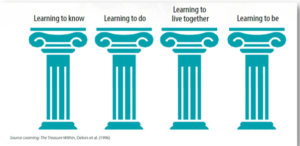1. Happiness and Happy Schools
1.3 Foundations of School Happiness
Child Happiness: From a child’s perspective, happiness might be like a big, warm hug from their favourite stuffed animal or the excitement of playing with friends on the playground. It’s the joy of discovering something new, like a colourful butterfly or a funny joke. Happiness for a child could also be the feeling of safety and love when they’re cuddled up with their family at bedtime, or the satisfaction of accomplishing something they’ve been working hard on, like building a tower of blocks or learning to ride a bike. Essentially, it’s about finding joy and delight in the simple things that make them smile and feel good inside.
School Happiness:
School Happiness aims to promote socio-emotional learning, mental health and well-being as a holistic perspective in the classroom and beyond. It provides school children with knowledge and life skills to flourish in their present and future lives. This approach is based on positive psychology, focusing on strengths and virtues that enable individuals, communities, and organisations to succeed and UNESCO-based pillars of learning, particularly learning to live together and learning to be.
Indeed, school happiness is based on UNESCO’s mandate of four pillars of learning and elements of positive psychology.
- UNESCO mandate calls for promotion of peace and justice through educational institutions based on pillars of learning i.e., learning to live together and learning to be. Learning to live together means understanding others. Learning to be means to enable the learners to reach their fullest potential and become good citizens of society.
- Concept of Positive psychology includes Social and Emotional Learning, well-being and Positive Teacher Attitude, Whole School Approach etc.
The framework consists of the promotion of peace and justice through educational institutions based on pillars of learning i.e., learning to live together and learning to be elements of positive psychology. It is an integral approach to education that prioritises the holistic well-being of students and the creation of a positive learning environment.
Here are some key points and principles :
- Socio-Emotional Learning
- Mental Health and Well-being
- Positive Psychology
- UNESCO Pillars of Learning
- Teacher Well-being
1. Socio-Emotional Learning (SEL) and Well-being: School Happiness focuses on promoting socio-emotional learning and mental well-being among students. This includes fostering skills such as self-awareness, self-management, social awareness, relationship skills, and responsible decision-making. Social and emotional learning (SEL) aims to help students better understand their thoughts and emotions.
2. Mental Health and Well-Being: Schools must be proactive in supporting the mental health of all participants, providing resources and interventions as needed.
3. Positive Psychology: The approach is grounded in positive psychology, emphasising strengths and virtues that enable individuals, communities, and organisations to succeed. This includes cultivating a positive teacher attitude, a whole-school approach, and promoting overall well-being.
4. UNESCO Pillars of Learning: School Happiness aligns with UNESCO’s mandate of promoting peace and justice through education, particularly emphasising the pillars of learning to live together and learning to be. Learning to live together involves understanding others and fostering community cohesion while learning to enable individuals to reach their fullest potential and become good citizens.
 UNESCO’s Education for Sustainable Development (ESD) Initiative indeed introduced a comprehensive framework for lifelong learning, encapsulated in four pillars:
UNESCO’s Education for Sustainable Development (ESD) Initiative indeed introduced a comprehensive framework for lifelong learning, encapsulated in four pillars:
Learning to Know: This pillar focuses on the acquisition of foundational knowledge and skills necessary to navigate the complexities of the world. It includes formal education components such as literacy, numeracy, critical thinking, and a broad understanding of various subjects. This pillar emphasises the importance of cognitive development and intellectual capacity-building.
Learning to Do: Here, the emphasis shifts to the acquisition of practical, applied skills essential for professional success and effective participation in the workforce. This includes vocational training, technical skills development, and hands-on experiences that prepare individuals for various careers and enable them to contribute meaningfully to society through their work.
Learning to Live Together: This pillar underscores the significance of developing social skills, values, and attitudes that foster harmonious coexistence within diverse communities. It promotes empathy, respect for others, appreciation of cultural diversity, and the ability to collaborate and communicate effectively across different backgrounds and perspectives.
Learning to Be: Unlike the previous pillars, which focus primarily on external outcomes, this pillar emphasises personal development and self-actualisation. It encourages individuals to explore their creativity, passions, and inner selves, fostering holistic growth encompassing mind, body, and spirit. Activities such as arts, sports, personal hobbies, and self-reflection contribute to this dimension of learning.
5. Teacher Well-being: The happiness of teachers is also highlighted as essential for creating a positive learning environment. Happy teachers are more likely to be effective in their roles and contribute to a supportive school culture.
Overall, the Foundations of School Happiness prioritize the creation of a nurturing and supportive educational environment where students can thrive academically, emotionally, and socially, ultimately contributing to their overall well-being and success.

